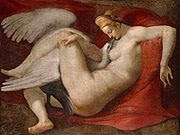
The theme of "Leda and the Swan" is the barbarism of human history. The myth of Leda and the swan was a popular theme in Renaissance art, but the story was deemed as romantic and charming. In Yeats's version, the tale is shown from the victim's point of view. Impregnated by Zeus, Leda will give birth to Helen and Clytemnestra. Faithless Helen will trigger the 10-year Trojan War. Clytemnestra will kill her husband, Agamemnon, and be murdered in turn by their vengeful son, Orestes. In other words, Western culture is doomed from the very start. It's origin is tainted with deceit, treachery, and violence.
How do you link this pessimism to Yeats's view upon the Western civilization? What does it mean when the poet wonders whether Leda, "being so caught up" in her brief encounter with God, gained "knowledge" of the meaning of history? What is the meaning of this "knowledge"? Do human beings become more "knowledgable" or "wiser" from the lessons of history?
